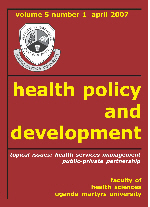
|
Health Policy and Development
Department of Health Sciences of Uganda Martyrs University
ISSN: 1728-6107 EISSN: 2073-0683
Vol. 6, Num. 3, 2008, pp. ii
|
Health Policy and Development Journal, Vol. 6, No. 3, December, 2008, pp. ii
In this issue …….
Code Number: hp08011
Dear Readers,
This issue of our journal brings you yet more
interesting and topical issues for perusal, debate and
policy.
The Editorial raises a key issue regarding the payment of health workers and health organisations – should they be paid automatic salaries and releases or they should be paid according to their performance? In the article on HIV/AIDS in the Bukoba region of Tanzania, Kamanzi A. challenges the interpretation and discourse of the Haya people regarding the disease. The article explores the early evolution of the disease in the region and also challenges previous perceptions regarding “African promiscuity” which have, hitherto, informed the biomedical approach to the management of the disease. Barugahara et al. throw light on the challenges facing managers of faith-based private-not-for-profit (PNFP) health facilities in Uganda regarding the management of government-seconded health workers. The article contributes to the debate on the possible options in order to improve service delivery and the public-private partnership for health. Nakiboneka and Maniple expose low uptake of natural family planning within Masaka Diocese, Uganda, and show that the necessary inputs to support clients who would want to use the approach are actually not provided. Therefore, the low uptake of natural family planning at Catholic health units in the diocese and the high utilisation of artificial family planning even by Catholics in the area are largely explained by the lack of political commitment to implementing the teaching of the Roman Catholic Church. Rahman et al. analyse the rural-urban differences in utilisation of ante-natal care (ANC) in Bangladesh and identify some of the determining factors. They find that urban women utilise ANC more than rural women, and that urban women are more likely to receive ANC of better quality than rural women. Key determinants of ANC use include the mother’s education level and parity. Nanyingi analyses the utilisation of laboratory findings in the treatment of malaria in Kabarole (low transmission area) and Nakasongola (high transmission area) districts of Uganda. The paper shows that despite the change of first-line malaria treatment policy from cheap to very expensive medicines, prescriber behaviour has not changed concomitantly and that this will result into excessive costs for individual patients and the national health system. Tumwebaze et al. analyse the management of cases of gender-based violence (GBV) in health facilities of Kabarole District, Uganda. The paper finds that there is no national policy, guidelines or standards for case management. The health facilities are understaffed and ill-equipped to manage the GBV cases. The health workers are also not trained to manage the cases. Finally, Murru analyses the concept of migration in general, bringing it down to international migration of health workers. The paper concludes that migration is inevitable and should only be managed properly to minimize the effects of recipient hostility to migrants. It ends with a prophecy that hostility to migrants will soon be over.
© Copyright 2008 - Department of Health Sciences of Uganda Martyrs University
| 